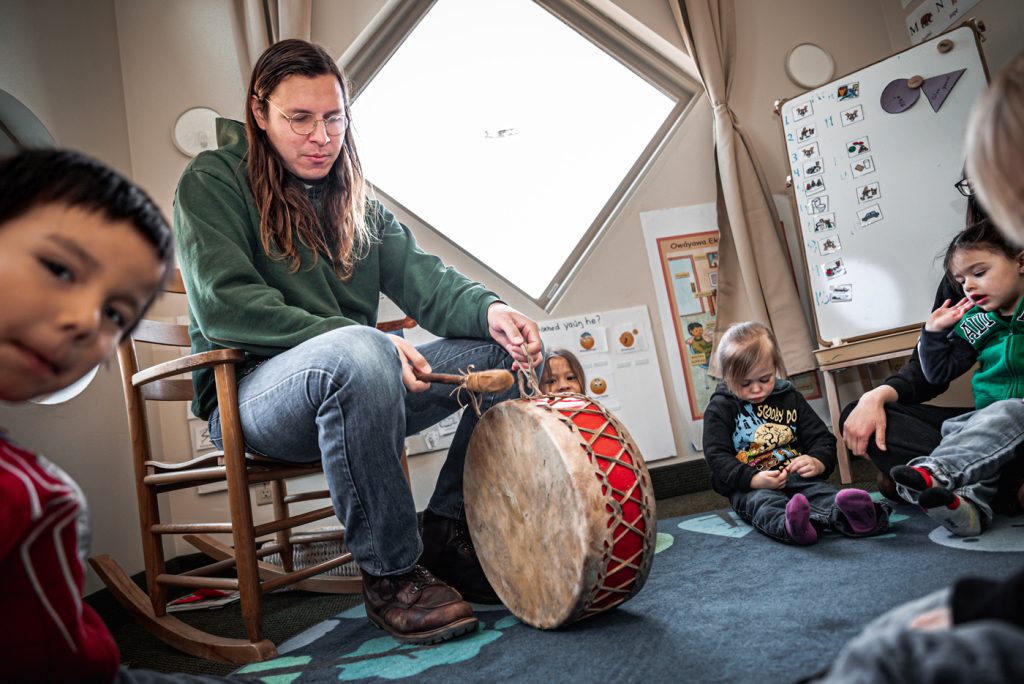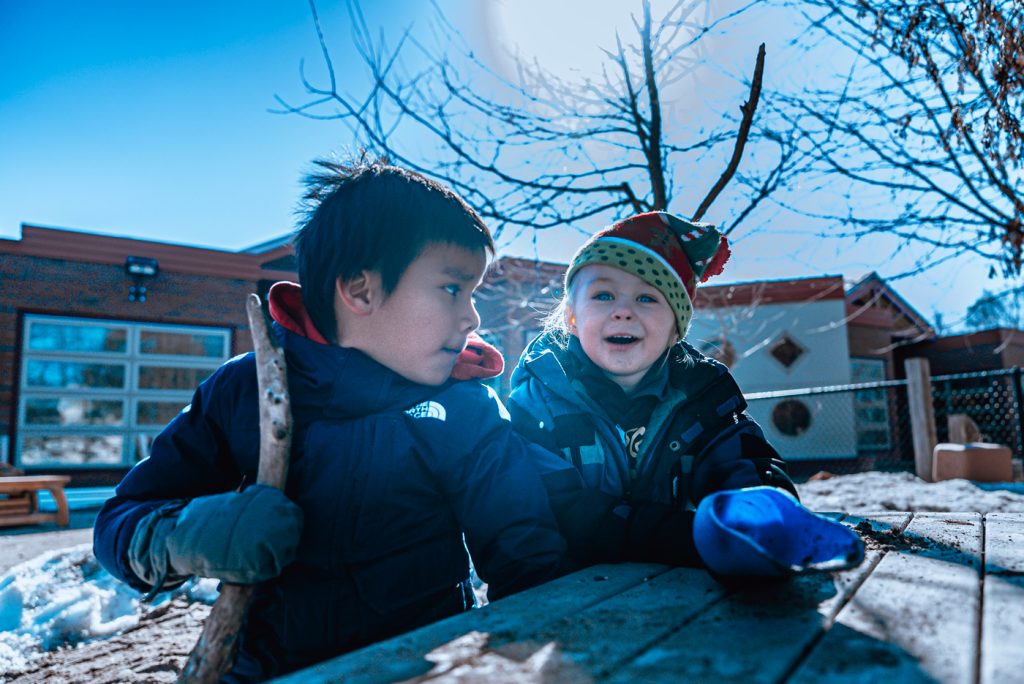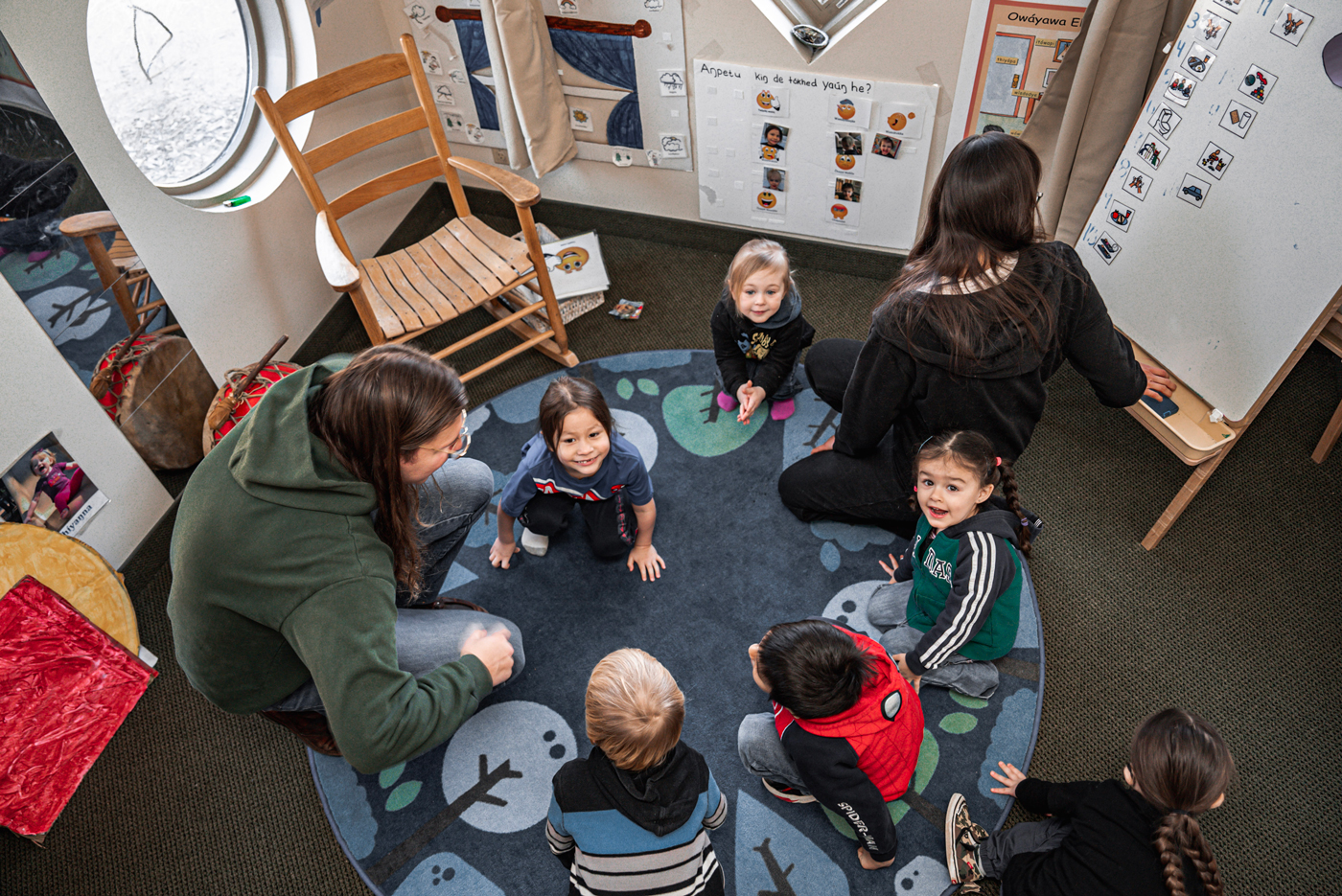A group of six preschoolers chatter excitedly as they settle into a circle to begin their morning. The beat of a drum starts a series of songs, and the children join in, taking turns saying their names and sharing how they’re feeling today. They pass a shell with smoldering sage to smudge—a traditional practice akin to a quiet reflection or prayer.
Every word spoken by the teachers is Dakhóta iápi, the language spoken in Dakota homelands since time immemorial. The children nod along knowingly and sometimes respond in Dakota. Each word they speak is a sign of hope for the future of the Dakota language—a critically endangered language that is being revitalized by a dedicated group at the University and across the region.
Here at the Dakhóta iápi Wahóȟpi (Dakota Language Nest), a small group of 3- to 5-year-old children and their teachers spend each day immersed in the language. The Wahóȟpi opened last September in a section of the Child Development Laboratory School (CDLS), which is administratively housed in the Institute of Child Development.
“This is Dakota land,” says Brenda Toscano, a first language Lakota speaker from the Pine Ridge Indian Reservation who is the lead teacher for the Wahóȟpi. “It saddens me that they’re really losing the language. It’s a race against time. When we’re all gone, who’s going to be here?”
From an idea to reality
The idea for the Wahóȟpi was planted several years before it became a reality and it took nearly four years before the doors opened. Šišókadúta, who is Dakhóta from Bde Hdakíŋyaŋ Oyáŋke (Lake Traverse Reservation), is a Dakota teaching specialist in the College of Liberal Arts’ Department of American Indian Studies. He had been looking to start a language nest in the Twin Cities for several years, partially because he knew there was an urgent need for teachers who were proficient in Dakota language and also had classroom experience.
“If we can start getting a lot of our students going to the Institute of Child Development, getting licensed, and getting student teaching experience in the language nest, then they can go back to their communities and they can start working in immersion nests themselves,” says Šišókadúta.
That is what led Šišókadúta to the CDLS. He worked closely with CDLS Director Sheila Williams Ridge to find funding for the program and get it ready to open. Finding teachers was a challenge, but they were able to hire both Toscano and Justis Brokenrope, a member of the Sičháŋǧu Lakȟóta (Rosebud Sioux tribe) who graduated from the University with a BA in American Indian studies and Dakota language focus in May 2022.
Brokenrope says that the children have absorbed so much of the language even in just a few months. The walls of the Wahóȟpi are covered in colorful posters featuring the Dakota words for wíškate (toys), oúŋčhaǧe (shapes), thiwáhe (family), and more.
“The kids speak English as their home language and that’s how they interact with each other, but their comprehension is good,” Brokenrope says. “They understand what is going on. Kids are sponges, they kind of just suck everything in and they spit it out however they want to.”

Photo credit: Jairus Davis
Learning on Dakota homelands
Williams Ridge says the nature-based learning focus at the CDLS also has a natural synergy with teaching in Dakota. The children spend between one-third and one-half of their day outside. Native plants like sage and sweetgrass were planted in their outdoor space, so the children can also learn traditional plant knowledge.
“The children are immersed in this place,” says Williams Ridge. “They are learning to love Minnesota. This Dakota homeland, they are learning to care for it.”
Šišókadúta says the building that houses the CDLS is located near an old Dakota trail that was used for trade and traveling. He says it’s important that the University continue to invest in Dakota language revitalization, especially because it is such a critical time for the preservation of the language. There is not an exact number of how many Dakota first-language speakers are alive, but most estimates say only a handful remain and they are elderly.
“The University has done a lot of negative things to our people,” he says. “It’s a land grant institution so the land was taken from our people and granted to them. If we don’t do anything now, what are we going to say to the future generations to come?”
Absorbing language like sponges
On a cold winter day, the children bundle up to head out for a walk to the nearby park. The challenges of early childhood are evident as they struggle into their cold weather gear, sometimes breaking down in frustration. One of the most common words heard in the Wahóȟpi is wašté—a word of encouragement meaning “good” or “it is good.”
“Preschoolers are not just language learners,” Williams Ridge says. “They’re learning everything. How to do that in the language has been such a learning curve. We’re starting with language as the core and then building early childhood skills around it.”
Toscano’s own experience with language in early childhood has been invaluable. Her family spoke Lakota, which is another dialect similar to Dakota. Her first setting outside of the home was a Spanish immersion school, where she picked up that language. Her first exposure to English was in kindergarten, where she then picked up her third language. After working as a nurse for years, she was approached by a Dakota community member who asked if she would consider bringing her language knowledge to the classroom. Since 2010, she has taught the language in early childhood settings around the Twin Cities.
“It’s such a treasure to work with little ones because this is where we need to start them at,” Toscano says. “They absorb it like sponges.”
Most of the day, the children chatter away in English. They clearly understand the Dakota spoken by their teachers because they respond to questions or follow directions given in Dakota. There is very little translation in the classroom. The teachers rarely break from Dakota, only if it is needed for safety. Little by little, the language is taking hold. As the children raced around the playground, tossing snow and playing with their teachers, suddenly one of them shouts out “Waŋná waškáte!”—“Now I’m playing!”

Photo credit: Jairus Davis
Growing teachers
In February, Šišókadúta, Toscano, and Brokenrope presented at the Dakota and Ojibwe Languages Symposium. Brokenrope shared that the goals of the Wahóȟpi are not only to create early childhood language learning opportunities for Dakota students and families, but also to increase enrollment by Indigenous students into the University’s early childhood program.
“We have student teachers now that come in and spend several hours a week in the classroom,” Brokenrope said at the symposium. “That’s not an opportunity I had when I was studying language.”
RickyMae Kitto, a Santee Dakota sophomore, is studying Dakota language with Šišókadúta and started working in the Wahóȟpi last fall. She says she grew up knowing about her Dakota lineage and that her ancestors had been exiled from Minnesota after the Common Dakota phrases U.S.-Dakota War of 1862, but she never heard the language spoken in her family. The legacy of Indian boarding schools, a federal Indian policy that began in the 1800s to assimilate Native children and continued well into the 20th century, resulted in several generations being forbidden to speak their Native language.
“Being in the nest and hearing all these little babies speak Dakota to you, it’s amazing,” Kitto says. “They don’t even know they are the future and they’re the ones who are going to break the cycle of us growing up without the language.”
Kitto says her goal now is to study both early childhood and Dakota language. She grew up taking care of younger children and now works at the Wahóȟpi and another preschool part-time, all to fulfill her dream of someday leading her own classroom.
Planning for the future

There are very few printed materials available in Dakota, so the staff has plans to create more
educational resources for other Dakota language programs.
Photo credit: Jairus Davis
As the Wahóȟpi wraps up its first academic year, there are many goals ahead for the program. This spring, Williams Ridge, Toscano, and Brokenrope traveled to Hawaii to visit Hawaiian language immersion programs, some of which have been operating for about 40 years and have contributed to a massive resurgence of their language. They plan to spend the spring and summer developing curriculum, translating books, and expanding the parent education program that meets weekly with the families of the Wahóȟpi children.
The Wahóȟpi is currently funded by a grant from the Minnesota Indian Affairs Council, as well as tuition from families. Williams Ridge says building the program may take years, but it is critical work that they hope to expand a little at a time. “If we don’t do it, who’s going to do it?” asks Šišókadúta. “We are the ones who have to do this and this is the time to do this.”
Learn more and make a gift to support the Dakota Language Nest.
-LORA HORGEN
 Circle time at the Wahóȟpi is spent learning traditional songs, as well as practicing interacting in Dakota.
Photo credit: Jairus Davis
Circle time at the Wahóȟpi is spent learning traditional songs, as well as practicing interacting in Dakota.
Photo credit: Jairus Davis